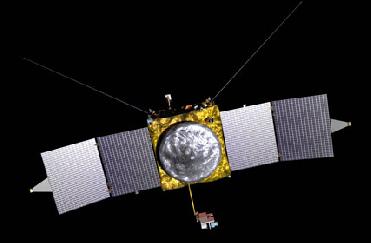
WASHINGTON (BNS): NASA has announced a robotic Mars mission for 2013 that could provide unprecedented insights into the Red Planet including its habitability.
The selection of the $485 million was the basis of its “best science value and lowest implementation risk from 20 mission investigation proposals submitted in response to a NASA Announcement of Opportunity in August 2006.”
"This mission will provide the first direct measurements ever taken to address key scientific questions about Mars' evolution," said Doug McCuistion, director of the Mars Exploration Program at NASA Headquarters in Washington.
Mars once had a denser atmosphere that supported the presence of liquid water on the surface. As part of a dramatic climate change, most of the Martian atmosphere was lost. MAVEN will make definitive scientific measurements of present-day atmospheric loss that will offer clues about the planet's history.
"The loss of Mars' atmosphere has been an ongoing mystery," McCuistion said. "MAVEN will help us solve it."
Lockheed Martin of Littleton, Colorado, will build the spacecraft based on designs from ongoing missions --Mars Reconnaissance Orbiter and 2001 Mars Odyssey missions. The mission design and implementation are expected to start in the mid-2009.
Launched in August 2005, the Mars Reconnaissance Orbiter is a multipurpose spacecraft that carries the most powerful telescopic camera ever flown to another planet. The camera can show Martian landscape features as small as a kitchen table from low orbital altitudes. The mission is examining potential landing sites for future surface missions and providing a communications relay for other Mars spacecraft.
The 2001 Mars Odyssey, launched in April of that year, is determining the composition of the Red Planet's surface by searching for water and shallow buried ice. The spacecraft also is studying the planet's radiation environment.
After arriving at Mars in the fall of 2014, MAVEN will use its propulsion system to enter an elliptical orbit ranging 90 to 3,870 miles above the planet. The spacecraft's eight science instruments will take measurements during a full Earth year, which is roughly equivalent to half of a Martian year. MAVEN also will dip to an altitude 80 miles above the planet to sample Mars' entire upper atmosphere. During and after its primary science mission, the spacecraft may be used to provide communications relay support for robotic missions on the Martian surface.
"MAVEN will obtain critical measurements that the National Academy of Science listed as being of high priority in their 2003 decadal survey on planetary exploration," said Michael Meyer, the Mars chief scientist at NASA Headquarters. "This field of study also was highlighted in the 2005 NASA Roadmap for New Science of the Sun-Earth System Connection."
The Mars Scout Program is designed to send a series of small, low-cost, principal investigator-led missions to the Red Planet. The Phoenix Mars Lander was the first spacecraft selected. Phoenix landed on the icy northern polar region of Mars on May 25, 2008. The spacecraft completed its prime science mission on Aug. 25, 2008. The mission has been extended through Sept. 30.
NASA's Mars Exploration Program seeks to characterize and understand Mars as a dynamic system, including its present and past environment, climate cycles, geology and biological potential.
The principal investigator for the mission is Bruce Jakosky of the Laboratory for Atmospheric and Space Physics at the University of Colorado at Boulder. The university will receive $6 million to fund mission planning and technology development during the next year. NASA's Goddard Space Flight Center in Greenbelt, Maryland, will manage the project.
 Next Article
Next Article












The Indian Air Force, in its flight trials evaluation report submitted before the Defence Ministry l..
view articleAn insight into the Medium Multi-Role Combat Aircraft competition...
view articleSky enthusiasts can now spot the International Space Station (ISS) commanded by Indian-American astr..
view article